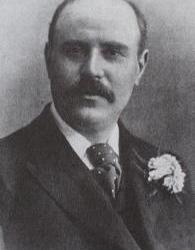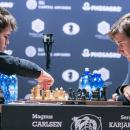Isidor Gunsberg

Bio
Isidor Gunsberg was an English/Hungarian master and a world-class player. He is best known for his world championship match with Wilhelm Steinitz in 1890/1891 and his win of the inaugural British Chess Association (BCA) tournament in 1885. Despite being a three-time British champion and a top player in the 1880s and early 1890s, his name is not as well-known as other masters of his era.
- Style
- Early Career To World-Class Player
- Challenger
- Chigorin Match
- World Championship Match
- Life After The World Championship
- Legacy
Style
Gunsberg's style was tactical and romantic. His games are full of brilliant tactical blows, swashbuckling sacrifices and buzzing piece activity. Gunsberg used many gambits in his repertoire, most notably the Evan's Gambit (which he used in the 1890/1891 World Championship) and the King's Gambit. In this early game, Gunsberg sacrifices pieces left and right (including his queen) before delivering mate:
Early Career To World-Class Player
Gunsberg was born in Hungary but moved to Great Britain in his early 20s. His first chess job was operating the chess automaton known as Mephisto. He operated the controls for the machine and won a chess tournament in this fashion in 1878. In 1879 Mephisto and Gunsberg went on tour and beat every male player that it faced (although it would resign to female players after achieving a won position).
By the 1880s Gunsberg started playing in larger tournaments. In 1885 he won the first BCA tournament held in London. Later that year Gunsberg won the German Chess Congress tournament in Hamburg ahead of Joseph Blackburne, James Mason, Siegbert Tarrasch, Henry Bird and many other masters. It was at this time that he was viewed as a world-class player.
In the next game Gunsberg sacrifices a piece before giving up his queen on move 20. The activity of his pieces is remarkable, and White is forced to exchange just to stay alive until he reaches a losing endgame:
In 1886 Gunsberg defeated two masters in match play—both Blackburne and Bird lost convincingly to Gunsberg. In 1887 he tied for first with Amos Burn in the third BCA championship ahead of Blackburne, Johannes Zukertort, Mason, Bird and other masters. In 1888 he again won the BCA championship, capturing his third British championship in four years.
Challenger
By 1889 Gunsberg was viewed not only as a world-class player but also as a potential challenger to World Champion Steinitz. The famous 1889 New York tournament can be viewed as the first candidates' tournament, as the winner would be able to challenge the world champion. Gunsberg had a good result, placing third behind Max Weiss and Mikhail Chigorin out of 20 master participants.
The tiebreak winner, Weiss, had no interest in playing Steinitz for the world championship, and Chigorin had just lost to Steinitz in a world championship match earlier that year. Instead of challenging Steinitz immediately, Gunsberg instead challenged Chigorin, who accepted. The match was played in Havana in 1890.
Chigorin Match
Although the match was not official, it was viewed that the winner would be the rightful challenger to Steinitz. The winner would be the first to score 10 wins (draws not counting), and in the event of a 9-9 score the match would be considered drawn. Chigorin had more experience than Gunsberg in match play and was considered the favorite heading into the match.
Chigorin took a very early 2-0 lead, but Gunsberg came roaring back and tied the score at 4-4 after winning the eighth game, which is notable because Gunsberg plays a quiet opening before unleashing his attack. Starting with a knight sacrifice on move 16, he chases Chigorin's king from g8 to b6 before the black king is in a mating net:
Gunsberg won games nine and ten and was leading the match with a 8.5-6.5 score after 15 games. Then it was Chigorin's turn to fight back, and he won the next three decisive games. Heading into the last game of the match, Chigorin was ahead a full point; however, Gunsberg won the final game and the score was at an even 11.5-11.5 (9 wins each).
The results of this fantastic match meant that Gunsberg had earned the right to challenge Steinitz in the eyes of the chess world. Gunsberg and Steinitz agreed to terms, and the 1890/1891 World Championship match was arranged to start in December 1890 in New York.
World Championship Match
The 1890/1891 World Championship match between Steinitz and Gunsberg was played with the same format as the Gunsberg-Chigorin match: The first to 10 wins, or the player with the most points after 20 games. Steinitz was considered the heavy favorite, as he was the reigning champion and had defeated Chigorin 10.5-6.5 in the previous year.
Steinitz struck first and won game two. However, the chess world was abuzz after Gunsberg won games four and five. Steinitz replied by winning games six, seven and 10—bringing the score to 6-4 in Steinitz' favor. In game 12 Gunsberg scored a brilliant win and brought the match to a 6.5-5.5 score.

In the memorable 12th game, Gunsberg plays his beloved Evan's Gambit. He quickly bottles up Steinitz' pieces, forcing the black queen to f8 and creating a bind. Gunsberg finishes the game with a beautiful exchange sacrifice, forcing the world champion to resign on move 24.
Steinitz struck back again with a victory in game 13, and after a few draws Gunsberg won another beautiful game. In game 16 Gunsberg played his Evan's Gambit masterfully. Because Steinitz must have completely missed 21. Ne4!, his queen is trapped! When was the last time you saw a world champion's queen trapped?
Gunsberg's win in game 16 brought the match score to within one point, 8.5-7.5 in favor of Steinitz. After a draw in game 17, an unusual situation occurred: Steinitz didn't show up for game 18! Despite sending a telegram to excuse himself from the game, his telegram didn't arrive on time. Gunsberg could have claimed the win in this game but declined the free point, which would have brought the match score to even with two games left.
This gentlemanly choice to decline the point may have cost Gunsberg the world championship title. When the 18th game was played, Gunsberg lost. This forced Gunsberg into a must-win position for the 19th game, but he could only draw. The match score ended 10.5-8.5 (six wins, four losses and nine draws) in favor of Steinitz, who retained his crown.
Life After The World Championship
After losing the 1890/1891 World Championship match Gunsberg would continue to play at a high level for a few more years. He finished tied for second in the 1900 London tournament. In the 1901 Monte Carlo tournament he finished in fifth place behind Carl Schlechter, Chigorin, Semion Alapin and David Janowsky, but ahead of Frank Marshall and eight other masters.

In the 1902 Monte Carlo tournament, Gunsberg's results began to slip. He finished in eighth place (tied with Marshall) behind Geza Maroczy, Harry Pillsbury, Richard Teichmann, Janowsky, Tarrasch, Schlechter, Chigorin and Heinrich Wolf (but ahead of 10 masters). Around this time the next generation of masters (led by future world champion Emanuel Lasker) proved too strong for Gunsberg.
He continued writing about chess and played games from time to time. In the following brilliant game from 1907, Gunsberg sacrifices his queen very early for incredible piece activity before putting the king in a mating net on the e5-square:
Legacy
Gunsberg will always be remembered for his match with Steinitz, but he should also be remembered as a three-time British champion and a creative tactician. His games and combinations are still studied in books and articles. He will always be a member of the elite group of world-class players who played for the world championship.

